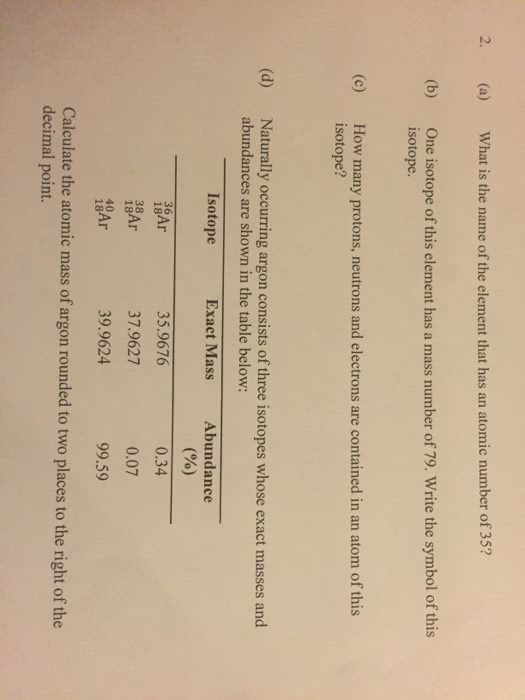CHE 110 Chapter Notes - Chapter 3: Chemical Formula, Plus And Minus Signs, Institute Of Noetic Sciences

Chapter 3: Stoichiometry
I. Atomic Mass
1) Atomic Mass
❖ The mass of an atom depends on the number of electrons, protons, and neutrons it
contains
❖ We cannot weigh a single atom but it is possible to determine the mass of one atom
relative to another experimentally
❖ Defined as the mass of the atom in atomic mass units
• Atomic Mass Unit = a mass exactly equal to one-twelfth the mass of one atom
2) Average Atomic Mass
❖ When we measure the atomic mass of an element, we must generally settle for the
average mass of the naturally occurring mixture of isotopes
❖ Calculating Average Atomic Mass
= (%abundance of isotope 1)(mass of isotope 1) +(%abundance of isotope 2)(mass of isotope 2)
II. A’ E
1) Moles (mol)
❖ The amount of substance that contains as many atoms, molecules, or other particles as
there are atoms in exactly X grams of the element-X isotope.
• Actual number of atoms is determined experimentally
2) Aogo’ Nm
, rounded to
3) Molar Mass
❖ The mass (in grams or kilograms) of 1 mole of units (atoms/molecules) of a substance
❖ Mass of 1 mole of Carbon-12
• 1 mole of carbon-12 atoms has a mass of exactly 12 g and contains
atoms
4) K A’ , we can calculate the mass of a single atom in
grams
❖ Mass of one carbon-12 atom
5) Conversions
❖ Mass of a Substance = Molar Mass
❖ S = A’
find more resources at oneclass.com
find more resources at oneclass.com

❖ Molecules of a Substance = Given in Formula
❖ Number of ATOMS or IONS
III. Molecular Mass
1) The sum of the atomic masses, in atomic mass units (amu), in the molecule
2) Molecular Mass of Water, H2O
3) From molecular mass, we can determine the molar mass of a molecule or a compound
❖ Molar Mass of a compound in grams is numerically equal to molar mass of a compound in
amu
❖ Molar Mass of H2O = 18.02 amu OR 18.02 g
IV. Mass Spectrometer
1) History
❖ Developed in the 1920s by F.W. Watson
❖ Provided indisputable evidence of the existence of isotopes
2) Method
❖ Gaseous sample is bombarded by a stream of high-energy electrons
❖ Collision between electrons and gaseous atoms/molecules produces positive ions by
dislodging an electron from each atom/molecule
❖ Positive ions are accelerated by two oppositely charged plates as they pass through the
plates
• Positive ions are of mass m and charge e
❖ Emerging ions are deflected into a circular path by a magnet
• Radius of circular path depends on the charge-to-mass ratio
• Ions of smaller e/m ratio trace a wider curve than those having a larger e/m ratio
➢ Ions with equal charges but different masses are separated from one
another
find more resources at oneclass.com
find more resources at oneclass.com
Document Summary
The mass of an atom depends on the number of electrons, protons, and neutrons it contains. We cannot weigh a single atom but it is possible to determine the mass of one atom relative to another experimentally. Defined as the mass of the atom in atomic mass units: atomic mass unit = a mass exactly equal to one-twelfth the mass of one atom, average atomic mass. When we measure the atomic mass of an element, we must generally settle for the average mass of the naturally occurring mixture of isotopes. = (%abundance of isotope 1)(mass of isotope 1) +(%abundance of isotope 2)(mass of isotope 2) A(cid:663)(cid:656)(cid:648)(cid:642)(cid:645)(cid:659)(cid:656)"(cid:660) (cid:628)(cid:662)(cid:654)(cid:643)(cid:646)(cid:659) (cid:642)(cid:655)(cid:645) (cid:661)(cid:649)(cid:646) (cid:627)(cid:656)(cid:653)(cid:642)(cid:659) (cid:627)(cid:642)(cid:660)(cid:660) (cid:656)(cid:647) (cid:642)(cid:655) e(cid:653)(cid:646)(cid:654)(cid:646)(cid:655)(cid:661: moles (mol) The mass (in grams or kilograms) of 1 mole of units (atoms/molecules) of a substance. Mass of one carbon-12 atom (cid:883)(cid:884) (cid:1859) (cid:1855)(cid:1853)(cid:1870)(cid:1854)(cid:1867)(cid:1866) (cid:883)(cid:884) (cid:1853)(cid:1872)(cid:1867)(cid:1865)(cid:1871) (cid:888). (cid:882)(cid:884)(cid:884) (cid:1876) (cid:883)(cid:882)(cid:2870)(cid:2871) (cid:1855)(cid:1853)(cid:1870)(cid:1854)(cid:1867)(cid:1866) (cid:883)(cid:884) (cid:1853)(cid:1872)(cid:1867)(cid:1865)(cid:1871)=(cid:883). (cid:891)(cid:891)(cid:885) (cid:1876) (cid:883)(cid:882) (cid:2870)(cid:2871)(cid:1859: conversions. Mass of a substance = molar mass.




